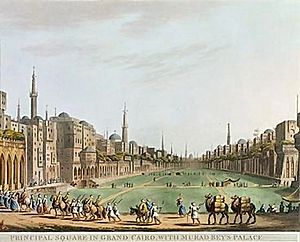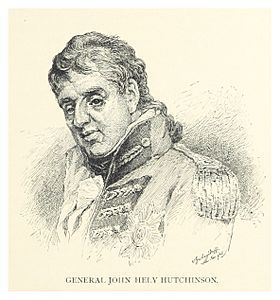Siege of Cairo facts for kids
Quick facts for kids Siege of Cairo |
|||||||
|---|---|---|---|---|---|---|---|
| Part of the French Campaign in Egypt and Syria of the French Revolutionary Wars | |||||||
 Principle Square In Grand Cairo, With Murad Bey's Palace circa 1801 |
|||||||
|
|||||||
| Belligerents | |||||||
| Commanders and leaders | |||||||
| Strength | |||||||
| 14,000 | 20,000 | ||||||
| Casualties and losses | |||||||
| 13,500 captured | Low | ||||||
The Siege of Cairo was a big battle during the French Revolutionary Wars. It happened between French soldiers and a team of British and Ottoman (Turkish) forces. It was one of the last major fights in the French campaign in Egypt.
The British commander, John Hely-Hutchinson, led his troops to Cairo. After some small fights, he arrived in mid-June. A large Ottoman army joined him. Together, they surrounded Cairo. On June 27, the French army of 13,000 soldiers, led by General Augustin Daniel Belliard, was outnumbered and outgunned. They had to surrender. The remaining French troops in Egypt, led by Jacques-François Menou, felt defeated and went back to Alexandria.
Why the Siege Happened
After General Ralph Abercromby died at the Battle of Canope, John Hely-Hutchinson took over as the British commander. On April 26, Major General Eyre Coote stayed to command the army near Alexandria. Hutchinson went to Rosetta to push the French out of the country, heading towards Cairo.
A British ship, HMS Leopard, arrived at Suez on April 21. It brought three smaller ships and many transport boats. About 6,000 local soldiers, hired from the East India Company in Bombay, were there to help. On April 22, British soldiers from the Leopard landed and took control of Suez. The French army had already left the town. The British flag was raised, and more troops arrived to set up camp.
On May 5, Hutchinson and his 8,000 British soldiers marched along the Nile River. They were heading towards the French position at El Aft. British and Ottoman gunboats supported them on the river. Meanwhile, Sir William Sidney Smith on HMS Tigre was looking for a French fleet. This French fleet, led by Rear Admiral Joseph Antoine Ganteaume, had four warships and five transport ships with 3,000 to 4,000 soldiers.
Ganteaume feared Smith's ships and sailed away. The five transport ships were empty of soldiers, as they had moved to the warships. But these transports carried many civilians. Smith's ships captured them on May 7. The British took all the supplies from the transports. With their fleet gone, the French left El Aft and moved back to El Rahmaniya on May 7. That same evening, the British and Ottoman troops entered El Aft, starting the Cairo campaign.
The Cairo Campaign Begins
On May 9, the British army moved to Er-Rahmaniyeh. French General Lagrange planned to hold his ground there. At 10 AM, British Royal Marines and sailors attacked the French forts at Er-Rahmaniyeh. Ottoman gunboats joined them at 4 PM. Soon, the French started a full retreat towards Cairo. They left 110 sick and wounded soldiers in the fort.
A group of fifty French cavalry soldiers from Alexandria was also captured. This meant the French in Alexandria could no longer communicate with their forces deeper in Egypt. The British and Ottoman forces had only five soldiers killed and 26 wounded.
On May 14, the British army continued its march towards Cairo. On their way, they captured a French armed ship and sixteen Feluccas (small boats). These boats were carrying wine, brandy, and clothing worth about £5,000. They also had 150 soldiers and heavy cannons. These supplies were going from Cairo to Er-Rahmaniyeh. The French commander did not know about the recent French defeats.
On May 17, a group of British cavalry and infantry, led by Brigadier General Doyle, got information from local Arabs. They stopped 550 camels guarded by 560 French soldiers. These French soldiers had left Alexandria on May 14 to get supplies from Middle Egypt. The French cavalry tried to charge, but British dragoons quickly caught up to them. The French surrendered under fair terms.
The small French army of about 200 soldiers at the fort of Ras El Bar was surrounded on the same day. British and Ottoman gunboats blocked them from the river side. Seeing this, the French left the fort and went to Port Said. The two French groups, totaling 700 men, left on five small ships. They hoped to reach Alexandria. However, four of these ships were captured and taken to Abu Qir Bay. Only one ship escaped to the coast of Italy.
On June 6, Colonel Lloyd and about 150 men from the 86th regiment marched across the desert to Cairo. They took a route to avoid meeting a larger French force. By June 10, these men joined Colonel John Stewart's group. They were to join Yusuf Pasha's (the Grand Vizier's) army on the right bank of the Nile.
Hutchinson moved his army to the village of Saael on June 14. Two days later, he moved closer to the French defenses, but still out of their reach. On the same day, the 28th Regiment of Foot and the 42nd Highland Regiment joined him. They had marched from Alexandria in twelve days. Meanwhile, the 320 soldiers under Stewart and Lloyd joined the Grand Vizier's army. On June 20, they arrived at Imbaba, a village near the fortress of Giza, across the Nile from Cairo. Here, they were directly opposite Cairo, where General Belliard had his large French army.
On June 21, Hutchinson made another move. The British and Ottoman forces surrounded Giza. They set up camp close to the French defenses on the other side of the river. By this time, the army besieging Cairo had grown to 20,000 men.
An important letter was found on a French General named Roize, who was killed at the Battle of Alexandria. The letter, written by French General Menou, showed he was worried. He feared the British would cut the embankment that formed the Alexandria canal. This would let sea water into Lake Mariout, blocking any escape for the French. The British engineers did this, flooding the area and making the canal useless. This left the French with no way out. There were some small fights that evening on both sides of the Nile. On June 22, the allied forces prepared to fully besiege Cairo and its forts.
General Belliard found himself completely surrounded. He could not communicate with other French forces, and there was no hope of help. On June 22, he sent a message to Hutchinson, asking to talk. They agreed that the French would leave Cairo and the areas around it.
After the Siege
The talks continued until June 28, when the French officially surrendered Cairo. They were given seventeen days to leave. According to the agreement, the French troops, about 8,000 healthy soldiers and 5,000 sick or recovering ones, would be taken to a port in France. General John Moore then escorted them to the coast near Rosetta. On the evening of June 28, the British and Ottomans took control of Giza and Cairo. The British and Turkish flags were raised together.
The last group of French soldiers captured in Cairo and other places sailed from Abu Qir Bay by August 10. Hutchinson had arrived back at his headquarters near Alexandria from Cairo. A part of the surrender agreement stated that any Egyptian who wanted to could follow the French army. Because of this, many Egyptian soldiers left their homes and later formed the Mamelukes of the Imperial Guard in France.
The British then focused on taking the last French stronghold in Egypt, Alexandria. This was the main goal of their mission. With Cairo secured, Hutchinson began the final attack on Alexandria. Between June 10 and 15, two groups of soldiers marched across the desert. By June 30, they reached the Nile River.
Soon, they arrived at Alexandria and surrounded it. After a siege from August 17 to September 2, 1801, the French surrendered again. This marked the end of the French army's presence in the Middle East.


